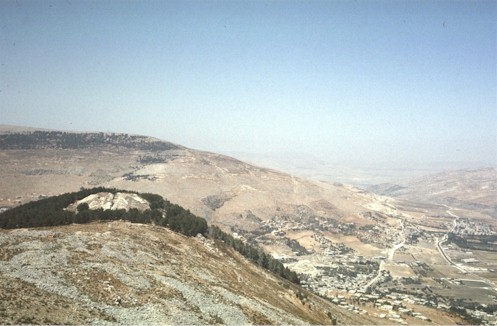Ancient Canaanite
city located 40 miles north of Jerusalem
& 5.5 miles southeast of Samaria (Sebaste)
on the only natural inland route between Judea
& Galilee.
The city was located at the southeastern end of the narrow pass
between Mt. Gerizim [2930 feet] & Mt. Ebal [3130 feet].
According to early Hebrew tradition, Abraham & Jacob built
altars there [Gen 12:6, 33:20]. And local legend identified the
well at the crossroads just north of town as Jacob's, whom Hebrew
tradition claimed had purchased a nearby field [Gen 33:19]. But
Shechem gained its primary symbolic significance when Joshua
made it the covenant center for the Israelite confederacy (13th
c. BCE; Josh 24, Deut
27). Though the city & its fortified
temple to the god of the covenant were later destroyed by
Abimelech, son of the charismatic Israelite chieftain Gideon, it
was rebuilt by Solomon. And later Israelite kings, including
Solomon's son Rehoboam & his rival Jeroboam were anointed
there. It served as the first capitol of the northern kingdom of
Israel, until Omri built Samaria as a more defensible strategic
site.
Shechem regained importance after the Babylonian exile,
when natives excluded from the temple in Jerusalem by
repatriated Judean exiles built a rival shrine on Mt. Gerizim.
Tensions between these rival shrines, each claiming to be the
sole heir of Mosaic tradition led to clashes between Jews &
Samaritans during the Hellenistic era. When the Hasmonean
dynasty in Jerusalem occupied the province of Samaria,
Johanan
Hyrcanus destroyed
Shechem & burned the temple on Mt. Gerizim (127 BCE).
Ancient Shechem was never rebuilt. But the importance of Mt.
Gerizim led to the foundation of a small Samaritan town nearer
to the well at the crossroad. According to John 4, Jesus stopped
there briefly on his way to Galilee. After the Romans destroyed
the Jewish temple (70 CE), a new city [Neapolis] was built in
honor of the emperor Vespasian
1.5 miles west of the ruins of the historic city. A small
community of a few hundred Samaritans with its own high priest
still lives in this city---which today is called Nablus---,
sacrificing lambs each Passover on Mt. Gerizim.
For further information about archaeological & historical evidence, see:
Other resources
on line:


![]()
![]()
![]()
![]() Perspective
on the World of Jesus
Perspective
on the World of Jesus ![]()